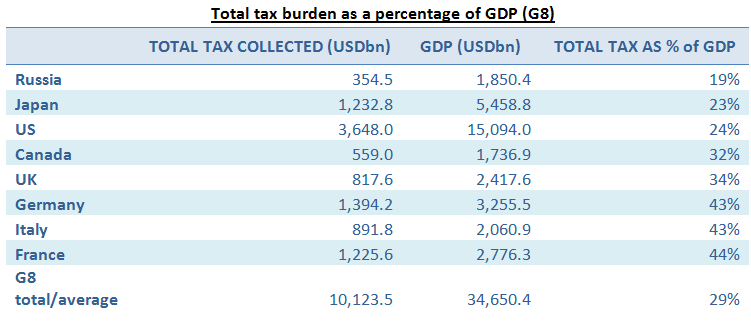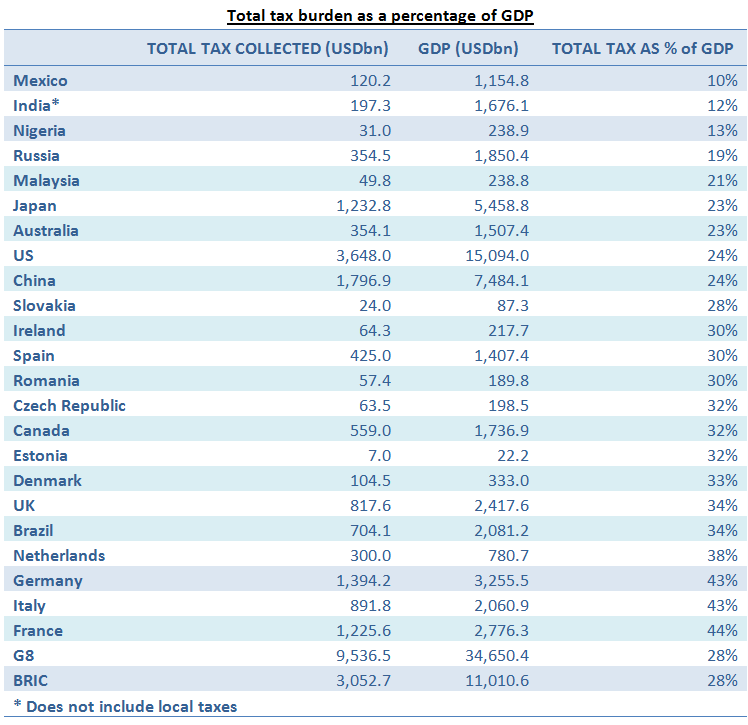The average tax burden of the major Eurozone economies is now nearly 44% (43.4%) of GDP, while the fast-growing "BRIC" economies still take, on average, less than 30% of GDP in tax, according to UHY, the international accounting and consultancy network.
UHY research shows that the three major Eurozone economies - Germany, Italy and France – collect on average 43.4% of GDP in tax. France imposes the highest tax burden among the nations studied, taking 44% of GDP in tax. Even the UK, which is seen as a relatively low tax country by some of its European competitors, is struggling with a burden of 34% of GDP.
According to UHY, many G8 nations have raised taxes over the last few years as governments have made efforts to reduce their debt levels. A higher tax burden, however, is often identified as an important factor inhibiting economic growth.
UHY professionals studied tax and GDP data for 23 countries across its international network, including the G8, as well as key emerging economies, including the BRIC nations.
John Wolfgang, chairman of UHY comments: "The comparison between the Eurozone countries and the BRIC and other Western nations is extreme. Generally speaking, the lower tax rate countries are experiencing higher growth, while most of the lower growth countries have higher tax rates."
"The G8 and BRIC nations both collected, on average, 28% (BRIC) and 29% (G8), but the G8 figure has been pulled upwards by its European members."
"High taxes are usually seen as an impediment to economic growth and can be a drag on competitiveness. When you look at these numbers, it's quite clear that, from a tax perspective, eurozone nations are pricing themselves out of the market. Many are raising taxes to pay down debts, eroding competitiveness even further – it's a Catch 22."
"While it can be argued that money taken out of the economy in tax is usually put back in by government, if taxes are being raised to service interest on debt rather than being invested, then it's very much a drain for the economy concerned."
John Wolfgang adds: "Eurozone countries have very few fiscal weapons left in their arsenals, but they do retain control of tax policy. Cutting taxes is likely to be one of the more viable options for boosting demand, but with tax revenues still falling or stagnant, securing the recovery while maintaining sound public finances will pose a significant challenge."
Among the 23 economies studied, the country collecting the lowest amount of tax as a percentage of GDP is Mexico. Mexico collected just 10% (see below) of GDP in tax (USD 120.2 billion in tax from a GDP of USD 1,154.8 billion).
The study by UHY also analysed the type of taxes collected by each country. Among the G8, for example, Russia and Italy collect the highest proportion of their taxes as indirect taxes at 33% (USD 116 billion and USD 295.2 billion respectively). The UK is the next highest at 32% (USD 260.9 billion).
UHY points out that these taxes are easier to collect, but are often seen as having a dampening effect on consumer confidence.
The study also shows that, among the G8, there is a wide gulf in the relative value of social security contributions collected as a proportion of total tax revenues. For example, 63.5% of all tax (USD 778.7 billion) in France is social security whereas, at the other end of the scale, specific social security taxes comprise just 18.4% (USD 151 billion) of all tax in the UK.
According to UHY, this is significant because the burden of social security partly falls on employers and is sometimes called a 'tax on jobs'.
The research also reveals that, among the Eurozone nations included in the study, only Ireland and Slovakia have tax burdens less than 30% of GDP. Germany, France and Italy have tax burdens of 43%, 44% and 43% of GDP, respectively. UHY says that this shows just how little room they have for maneuver in terms of raising taxes to shore up public finances, while at the same time trying to stimulate economic growth.
The UHY research shows that, among the 23 countries studied, Mexico collects the lowest amount of tax as a proportion of GDP at just 10%.
CP Oscar Gutierrez Esquivel, of UHY Glassman Esquivel y Cía, member firm of UHY in Mexico comments: "Over the last few decades Mexico has implemented liberal reforms, reducing the role of the state in the economy and the overall tax burden. This has left Mexico with very competitive tax rates amongst major economies. While low taxes alone are not sufficient for economic growth, they have laid the foundations for Mexico to become one of the fastest growing economies in the world today."
"However, it is very important that the Government improves its tax collection rates as these fall short of the revenue that the Government should expect to be collecting."
The UHY study also reveals that Italy has one of the highest tax burdens as a proportion of GDP at 43%.
Andrea D’Amico of FiderConsult Srl, member firm of UHY in Italy, comments: "The tax burden in Italy has been creeping up since the financial crisis as the Government has implemented its deficit-reduction programme, which very likely will further increase the tax burden for future years."
"The problem for Italy is that the tax burden is not compatible with a steady rate of economic growth. It's a very difficult balancing act, but the Government needs to find ways of reducing the amount taken out of the economy in tax, while simultaneously taking actions to improve the economic growth and international competitiveness."





